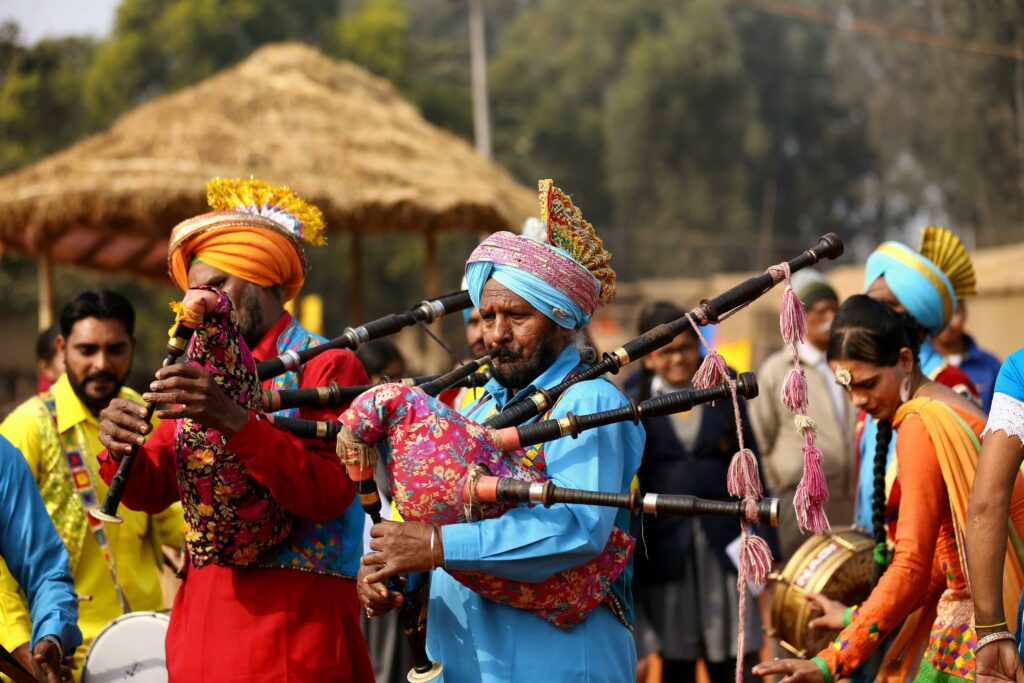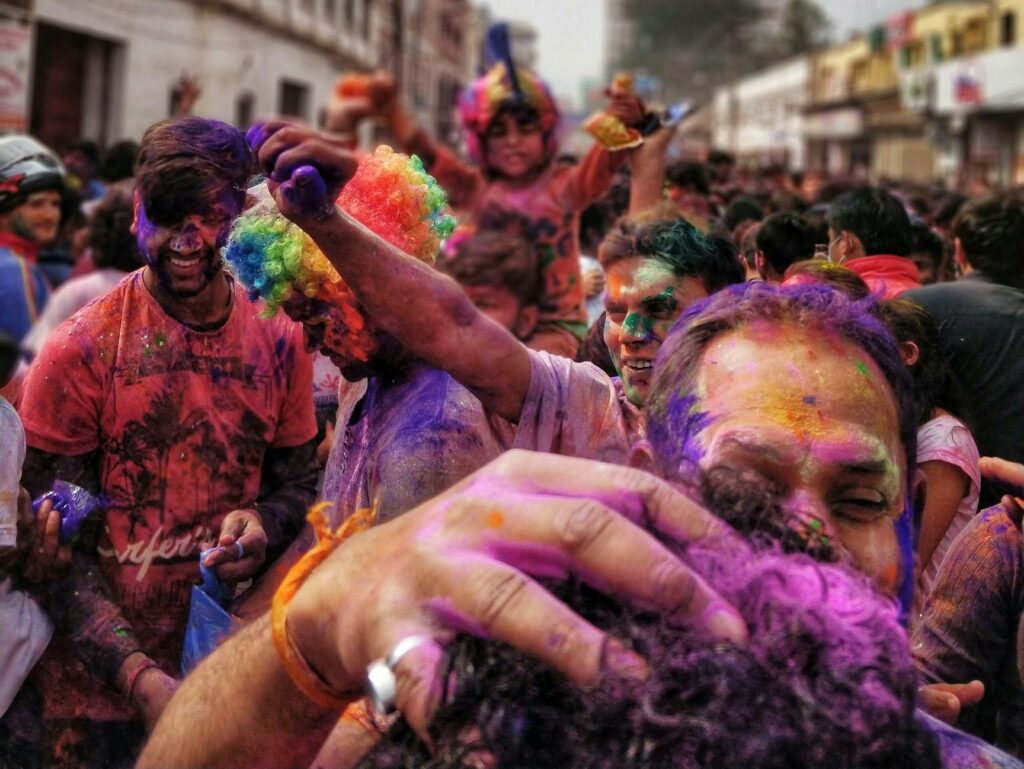Nepal’s Most Vibrant Festivals: A Cultural Spectacle of Tradition and Celebration
Nepal, a land defined by towering mountains, flowing rivers, and ancient traditions, offers a unique rhythm. Each month, the air shifts, the streets come alive, and the spirit of the people stirs. Festivals arrive with the seasons—unmistakable, powerful, and vibrant.
These celebrations are anything but subdued. The beat of drums fills narrow alleyways, firelight dances across temple walls, and voices rise in harmony. Gods are carried through the streets, offerings burn, and monks chant in unison. Faces radiate devotion, and the very earth hums with energy.
For those who approach with an open heart, this isn’t just a journey; it’s a transformation—into belief, heritage, and the timeless spirit of Nepal. You don’t simply observe; you become part of it.
From Hindu deities paraded beneath golden canopies to silent processions illuminated by flickering butter lamps, Nepal pulses with meaning. To truly feel this land, visit when the streets are alive. Come when the temples shine and the night echoes with voices reaching beyond the visible.
We offer you a way to witness, walk alongside, and immerse yourself in these living traditions. These festivals are more than events; they are experiences that demand to be lived.

Dashain – The Grandest Hindu Festival
Dashain, Nepal’s longest and most cherished festival, is celebrated nationwide with unmatched enthusiasm. During this 15-day festival, the victory of good over evil reaches its highest point when Goddess Durga defeats the demon Mahishasura. Religious observances during Dashain extend beyond worship, featuring major gatherings with family members, plentiful feasting, and various celebratory customs.
What to Expect as a Traveler?
- On the main day of Vijaya Dashami, Nepali elders perform two important rites: first, they apply tika (a mixture of yogurt, rice, and vermillion) to younger family members, followed by giving jamara (barley sprouts), symbolizing luck and abundance.
- During the holiday period, Nepalese communities come together through kite flying and bamboo swings (ping), reinforcing unity and festivity.
- On Maha Ashtami and Maha Navami, devotees visit Goddess Durga’s temples, where they perform traditional animal sacrifices as offerings.
- Transportation hubs become extremely crowded as Nepalis travel home to celebrate with their families, further intensifying the festive spirit.
Tihar – The Festival of Lights
Tihar, also known as Deepawali, is Nepal’s second most significant festival after Dashain. This five-day celebration honors animals, deities, and human relationships while illuminating homes and streets with lights and joy.
Highlights – Five Days of Light, Devotion, and Celebration
- The crows call, marking the start of Tihar. Kaag Tihar begins. Food is left for them, a sign of respect, a way to appease messengers of the beyond.
- The dogs wait. Kukur Tihar comes next. Garlands hang from their necks. Tika marks their foreheads. They are protectors, guardians, loyal beyond words.
- The lamps glow. Laxmi Puja fills homes with light. Rangoli spreads across doorsteps. Wealth is welcomed. The goddess watches.
- The Newars sit in quiet ritual. Mha Puja is for the self. Beyond them, in fields and courtyards, others honor cows and oxen, the lifeblood of the land.
- The brothers arrive. Bhai Tika unites them with their sisters. Seven colors mark their foreheads. Gifts are exchanged. Wishes are spoken. Bonds, unbroken.
Holi – The Festival of Colors

Photo by Sahil Prajapati
The “Festival of Colors,” specifically known as Holi, stands as one of the major Hindu festivals that Nepalese people celebrate with great enthusiasm. The festival takes place on the full moon day of Falgun (March), marking the arrival of spring and the triumph of good over evil. Nepalese celebrate Holi across two consecutive days, with the first observance in hilly and mountainous areas, followed by celebrations in the Terai region on the next day.
Holi, Nepal’s vibrant festival of colors, falls during peak trekking season, creating a perfect time for celebration and adventure. Join the festivities before setting off on popular treks in Nepal.
For a smooth, professionally guided experience, Nepal Hiking Team is the premier choice—renowned for its expertise, commitment to ensuring safety, and unwavering dedication to turning your trekking aspirations into reality.
Where Holi Takes Over the Streets
- Basantapur and Thamel – The heart of Holi beats here. Colors fly. Music echoes. Locals and travelers move as one, dancing, laughing, lost in the festival’s rhythm.
- Water Balloons and Color Powder – Hands reach. Colors splash. Red, blue, yellow—faces covered, smiles bright. Water balloons soar. Laughter fills the air.
- A Day for Celebration – Holi is a public holiday. Offices close. Schools stay silent. The streets take over. The city becomes color, movement, and joy.
Indra Jatra – Kathmandu’s Biggest Street Festival
Indra Jatra, known as Yenya, sweeps through Kathmandu with drums, masks, and gods carried through the streets. It honors Indra, the god of rain, the king of heaven. The city moves with sacred processions, dancers leaping in fierce masks, and the Living Goddess Kumari watching from her chariot. Indra Jatra is celebrated in the Nepali month of Bhadra, which is usually in August or September. The chariots will roll again. The crowd will follow. The city will not stand still.
Why Should Travelers Experience Indra Jatra?
- Kumari jatra -Living Godess in Motion: The chariot moves through the streets. Kumari, the Living Goddess, looks out. Her presence is sacred. Beside her, Ganesh and Bhairav ride, their statues towering over the crowd.
- Drums pound. Lakhey, the demon, dances wildly, his red mask flashing through the streets. Pulu Kisi, Indra’s elephant, surges forward, its wicker frame shaking with each step. The past comes alive.
- As the city celebrates, families pause. Butter lamps flicker. The Mata Biye ritual begins. The lost are remembered. The living move forward.
Buddha Jayanti – Celebrating the Birth of Lord Buddha
Buddha Jayanti, also called Buddha Purnima or Vesak, is the holiest Buddhist festival. It honors the birth, enlightenment, and passing of Gautama Buddha. The day falls on the full moon of Baisakh (April–May). Nepal marks it with quiet devotion and grand rituals. Monks murmur. Lamps bright and glow. Prayer flags flatter with the wind.
Best Places to Celebrate Buddha Jayanti in Nepal
Lumbini – The Birthplace of Buddha – In Mayadevi Temple, at the Ashoka Pillar, in the sacred gardens, prayers rise with the morning light. Monks gather. Devotees bow. The air is still, heavy with devotion.
Swayambhunath and Boudhanath Stupas – Butter lamps flicker. Monks chant. The wind carries whispered prayers. Visitors sit in silence, lost in thought, in peace.
Kheer and Offerings – Sweet rice pudding, Kheer, is shared. A reminder of Buddha’s path. A simple dish. A deep meaning.
Gai Jatra – The Festival of Cows and Humor
Gai Jatra, the Cow Festival, moves through the streets of Nepal. It is grief and laughter, loss and tradition. Families who have lost loved ones walk with a cow or a child dressed as one. The path is sacred. The journey, a farewell. This festival runs deep in Hindu belief. The cow leads souls forward, guiding them beyond. The living remember. The dead move on.
Gai Jatra falls in August/September. The streets will fill with masks, music, and quiet prayers. Life and death, walking side by side.
Why It’s an Experience Travelers Should Not Miss
- Processions of Cows and Children – Families walk through Kathmandu, Bhaktapur, and Patan. Some lead cows. Others dress their children in bright colors. The streets move with them.
- Satire and Street Performances – Laughter echoes through the crowd. Skits mock leaders. Jokes soften sorrow. Grief and humor share the same stage.
- A Tradition Born from Loss – Long ago, a king sought to ease his queen’s sorrow. Now, the people do the same. Gai Jatra stands for resilience, for remembrance, for life moving forward.
Conclusion
Nepal’s festivals are the heartbeat of its people. They are faith in motion, history alive in the streets. Holi fills hands with color, binding strangers in joy. Indra Jatra moves through Kathmandu, where the living goddess watches from her chariot. Buddha Jayanti glows in candlelight, prayers rising with the wind. Each celebration carries centuries of devotion, each moment a reflection of Nepal’s soul.
For those who travel here, these festivals are more than sights to see. They are invitations. A hand reaching out, a voice calling you to step closer. Walk with the crowd. Feel the drums beneath your feet. Sit with elders who share their stories. This is Nepal—not only to witness but to belong.
When will you stand among them? Let’s begin the journey.
A weekend at Rotterdam's quirky contemporary art festival

